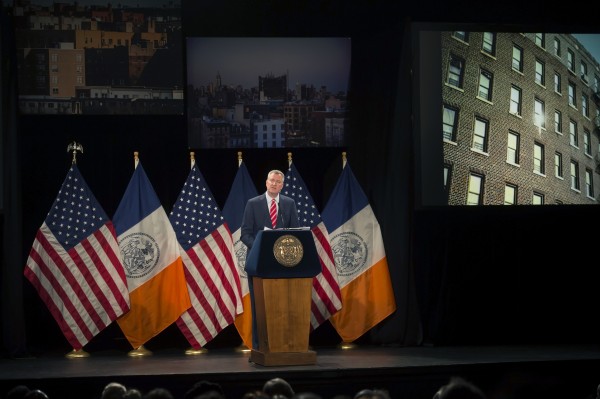
Mayor Bill de Blasio on Tuesday delivered his second State of the City address. Photo Courtesy of Demetrius Freeman/Mayoral Photography Office
The central tenet of Mayor Bill de Blasio’s second State of the City address, delivered on Tuesday at Baruch College in Manhattan, mimicked that of his 2013 campaign when he consistently raised the concept of the city careening toward “a tale of two cities.”
With the continued fight against economic inequality as the foundation, de Blasio on Tuesday looked to Queens as a key to leveling the playing field and realizing the vision of what he called “One New York.”
The State of the City highlighted elements of de Blasio’s ambitious Housing New York plan to build and preserve 200,000 affordable homes in the coming decade.
“This administration is taking a fundamentally different approach—one that not only recognizes the need for more affordable housing, but demands it. How will we do this? First, we’re writing new rules, ones that mandate affordable housing as a condition of development in areas rezoned for residential use. Second, we’ll do everything in our power to keep those who already have affordable housing in their homes. And third—since we only have so much land—we’ll create more affordable housing by literally building up: adding density to appropriate parts of our city,” de Blasio said.
Long Island City and Flushing West are two of the first six neighborhoods now being studied for more residential capacity, and a Mandatory Inclusionary Housing policy will require all new housing built under rezoning to include affordable units. The first rezoning will enter the formal land use process this spring.
De Blasio promised to support growth by improving infrastructure. To that end he announced the development of the Five-Borough Ferry System, which will knit together existing East River routes with new landings and services to Astoria, the Rockaways, South Brooklyn, Soundview and the Lower East Side. Rides will cost the same as a Metrocard fare; service will launch in 2017 and will be backed by city operating support and a $55 million capital commitment.
To connect growing neighborhoods and improve commutes, de Blasio said the city will develop and implement 13 new Bus Rapid Transit routes through 2017. Improved service, off-board fare collection, dedicated bus lanes and reduced travel times will speed commutes on Woodhaven Boulevard, Utica Avenue, Flushing-to-Jamaica, and 86th Street during the next immediate wave of expansion. The city will partner with the Metropolitan Transportation Authority, the state and US Department of Transportation to secure multi-level support for the Select Bus Service program, starting with a $295 million commitment from the administration.
For victims of Superstorm Sandy in Queens, Brooklyn and Staten Island, de Blasio had this promise: “I want to make perfectly clear that every reimbursement check will be in the hands of those who need them by the end of this year. From Staten Island to Canarsie to the Rockaways, families hit by the storm have been through so much. This administration will finish the job of helping them rebuild.”
In closing, de Blasio set out something of a to-do list as Gotham unfurls 2015.
“Creating more affordable housing; raising wages and benefits; strengthening our neighborhoods by better connecting them to jobs and opportunity—that is how we’ll take on the Tale of Two Cities,” he said.
By Michael V. Cusenza
